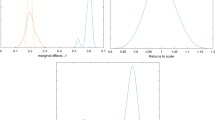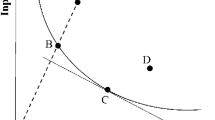Abstract
Estimation of either price or quantity allocative efficiency parameters provides an empirical method for taking into account the presence of allocative inefficiency. We show that the researcher can either (a) estimate a system of input demand functions of the form, \(x=h(y,k{\circ} w),\) obtain estimated values of the price allocative efficiency parameters (the k′s), and then derive the quantity allocative efficiency parameters with a simple calculation or (b) estimate a system of shadow price functions of the form, \(w=g(y,\delta{\circ} x), \) obtain estimated values of the quantity allocative efficiency parameters (the δ′s), and then derive the price allocative efficiency parameters with a simple calculation. These input-specific efficiency measures are then related to the standard measures of efficiency that have appeared in the literature.


Similar content being viewed by others
Notes
We wish to thank an anonymous referee who suggested that we explore this relationship.
References
Atkinson S, Cornwell C (1994) Parametric measurement of technical and allocative inefficiency with panel data. Int Econ Rev 35(1):231–243
Atkinson S, Halvorsen R (1980) A test of relative and absolute price efficiency in regulated utilities. Rev Econ Stat 62(1):81–88
Atkinson S, Halvorsen R (1984) Parametric efficiency tests, economies of scale, and input demand in US electric power generation. Int Econ Rev 25(3):647–662
Atkinson S, Primont D (2002) Stochastic estimation of firm technology, inefficiency, and productivity growth using shadow cost and distance functions. J Econ 108:203–225
Atkinson S, Färe R, Primont D (2003) Stochastic estimation of firm inefficiency using distance functions. South Econ J 69(3):596–611
Averch H, Johnson L (1962) Behavior of the firm under regulatory constraint. Am Econ Rev 52((No. 5):1052–1069
Färe R (1984) The dual measurement of efficiency. Zeitschrift für Nationalökonomie 44:283–288
Farrell M (1957) The measurement of productive efficiency. J R Stat Soc Ser A, Gen 120:253–281
Lau L, Yotopoulos P (1971) A test for relative efficiency and an application to indian agriculture. Am Econ Rev 61:94–109
Lovell CAK, Sickles R (1983) Testing efficiency hypotheses in joint production. Rev Econ Stat 65:51–58
Toda Y (1976) Estimation of a cost function when cost is not a minimum: the case of soviet manufacturing industries 1958–71. Rev Econ Stat 58:259–268
Author information
Authors and Affiliations
Corresponding author
Rights and permissions
About this article
Cite this article
Färe, R., Primont, D. Dual allocative efficiency parameters. J Prod Anal 37, 233–238 (2012). https://doi.org/10.1007/s11123-011-0240-4
Published:
Issue Date:
DOI: https://doi.org/10.1007/s11123-011-0240-4




